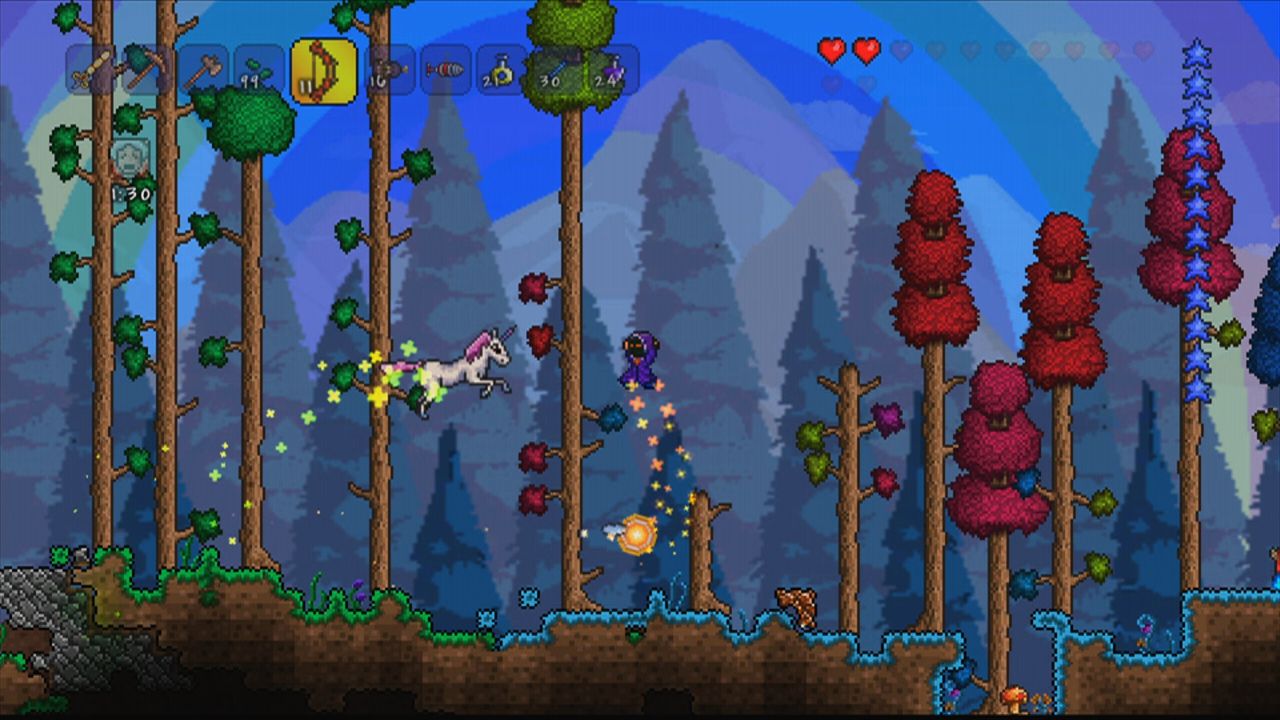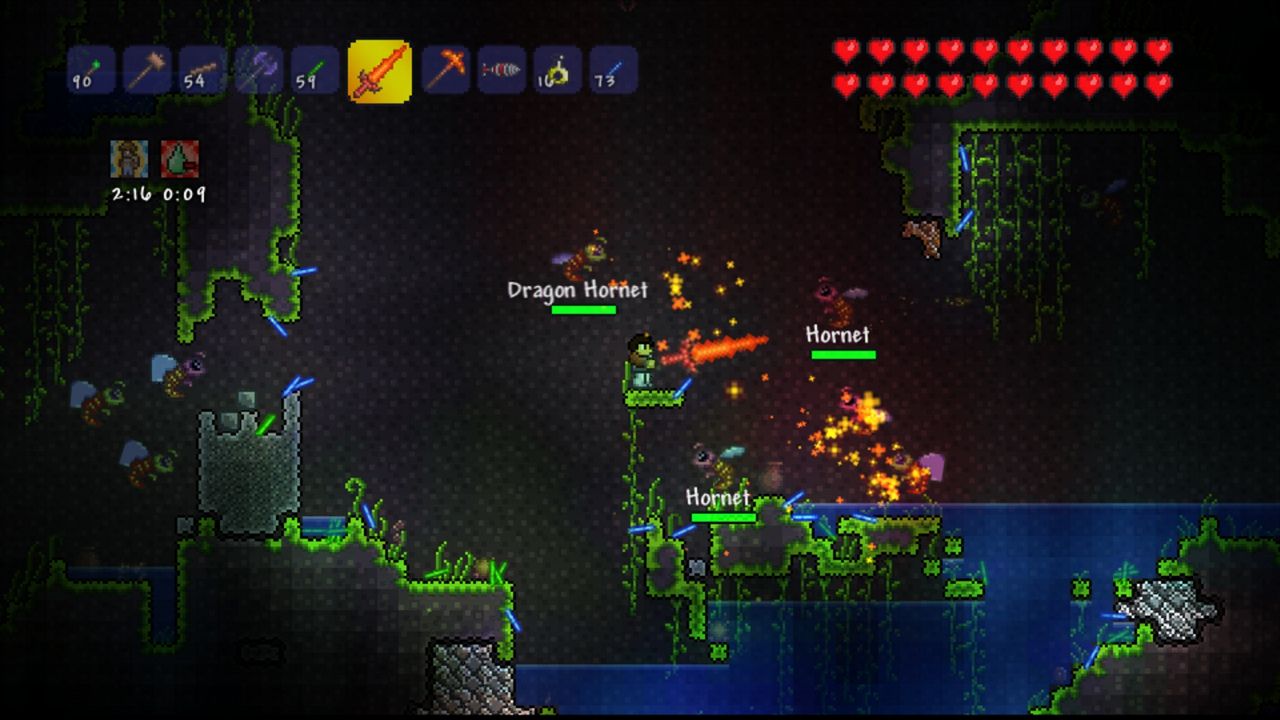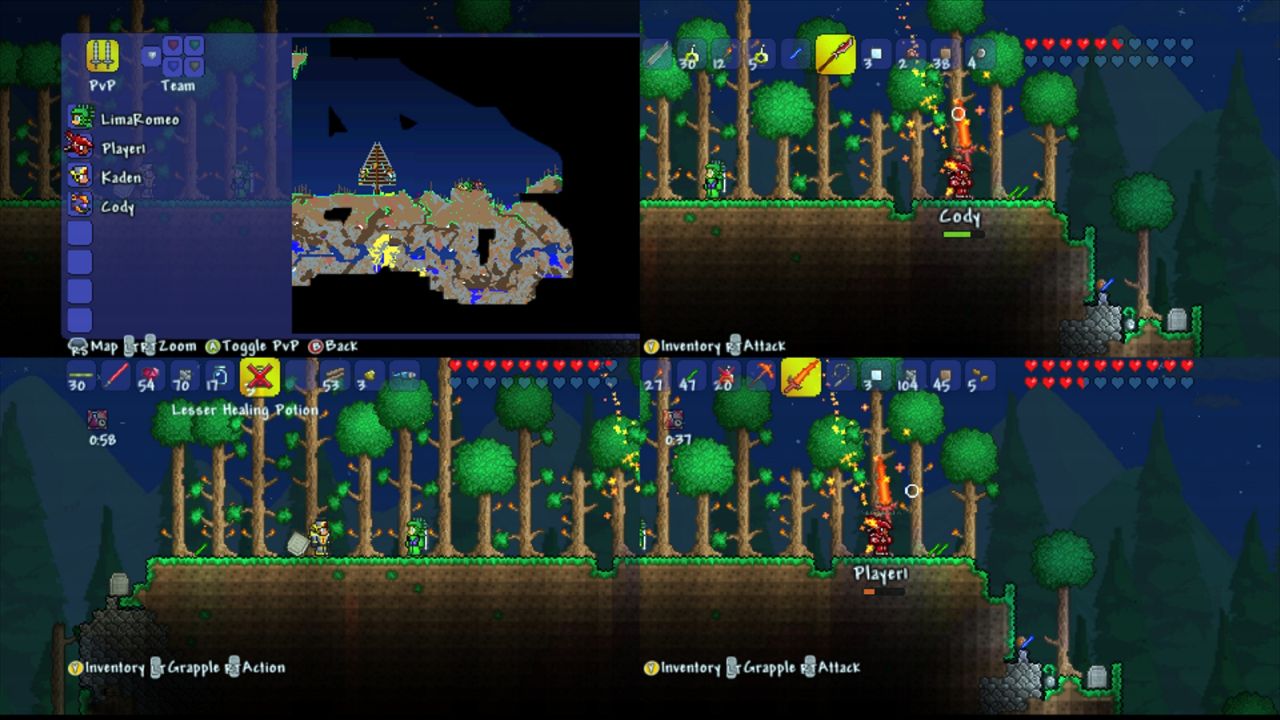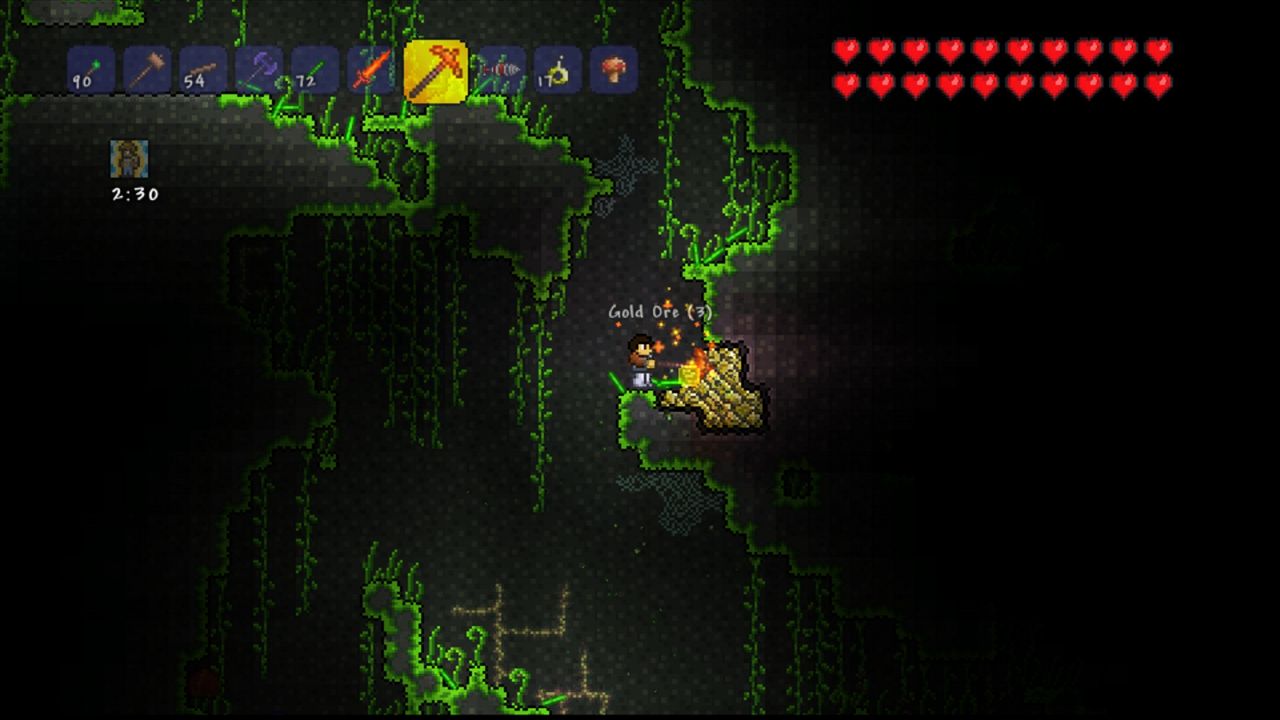Terraria Review
With so many games being over in the blink of an eye, sometimes you just want something that demands an immense proportion of your time. For better or worse, Terraria is that game. Comparisons have been raised to Minecraft and if you flatten the game into a 2D playing field that’s not a bad place to start.
Terraria’s rocking a very retro 8-bit look that despite adequately serving the 2D design is sadly something of an eyesore. Thankfully, the gameplay manages to pull you in regardless. If the visuals weren’t off-putting enough for what’s bound to be an incredibly niche title, there is almost no guidance on what you’re supposed to be doing. Put simply you need to dig downwards from the surface, take on a few bosses, until you reach Hell and take on the final boss.

The game has been out on the PC platform for a while now, but there have been some tweaks to make the game more console-friendly. For starters, there’s now something resembling a tutorial, which walks you through basic crafting, exploration and combat. Cursor controls have been tweaked to work with a pad instead of a mouse too. And if the original challenge wasn’t enough, then there’s a new final boss to look forward to in the months ahead.
From the start, you select a difficulty from a range of options that include various punishments for death. The friendliest takes some cash, the middle your inventory items too, while the final one permanently kills you. Fun! Playing on the nicer settings at least lets you pick up your loot if you make it back to where you died, Demon’s Souls-style. You’ll also choose the size of the world you want to create from small, medium and large. Worlds and their landscapes, terrains, tunnels and items are all randomly generated. Even the small option is bewilderingly huge, so don’t feel you’re chickening out by trying that option first.
Upon spawning on the world’s surface (please, do the tutorial first), you’ll want to go about building yourself a house immediately. You’re given a basic sword, pickaxe and axe. Use the axe to hack trees for wood and use the pickaxe to mine some stone squares. Using these items you can make a square outline (or any shape you want) to make a building. Then fashion a table from the wood, which is from where Terraria’s crafting system unfolds. From here, create and attach a door, lighting, wall panels and a chair to confirm it as a residence so a wandering NPC can move in and offer advice. Each property you build will potentially be adopted by NPCs, some of whom will be merchants. Also, if you are killed, you will respawn at the original residence.

During this early construction project, you’ll get to grips with the analogue controls for placing objects. There are two modes; the first is useful for mining and digging as you point the right stick in the direction you want to hack. Click the R3 button and you can target specific squares (everything is made from square blocks). The later allows more precision, but is often very unresponsive as I frequently discovered when trying to place objects; doors were particularly reluctant to affix.
The game’s inventory system can be a nightmare to navigate too, with you having to move objects into the top bar to use them in the game itself. This top bar of items can be selected from with the shoulder buttons outside of the menus, but the response times can be sluggish, which is annoying when you want to swap from a mining tool to a decent weapon upon a surprise attack.
Once you’ve created a home it’s time to head outside. Undiscovered areas of the map screen are blacked out so where you head next is entirely up to you. While heading down into the ground is where the game ultimately wants you to go, there’s a surprising amount of land to discover on the surface too.
After a few expeditions I travelled through forests, deserts and winter landscapes, but more often than not I was tempted underground, especially as zombies come out for a munch at nightfall. You can start digging from the surface or investigate a crack in the ground to get a head start. Essential tools to take along are fire torches and wooden platforms. The darkness underground is very close but you can stick a torch in any surface as a permanent fixture, which is a handy and considerate touch.
Extra platforms are useful if you have dug down too straight to jump back out again, so try to dig diagonally. There’s nothing more embarrassing than having to ‘dig up’ to get out of a hole. Oh actually, there is, like remembering very late on you can lay down any picked up soil/stone blocks to rebuild an exit.

Mining through the darkness is often more than a little scary, as at any time you could dig your way into a cavern and fall down into whatever lies below. This could be a neck-breaking drop, treasure, new enemies or even one of the terrifying boss fights.
Combat is very basic, with similar targeting to mining. Early enemies are just bouncing gel blobs and worms but later monsters often ensure you’ll dig in the opposite direction. You can jump and attack to take care of vultures and other flying pests and a bow and arrow is available if you like taking on enemies at a distance, which is something of a luxury in mined tunnels. Grappling hooks enable better movement skills later on in the game, but you could be looking at a serious amount of hours before crafting one of these. It’s going to be at least a dozen hours before you’re even allowed to look at a boss and even then you’re going to last about five seconds.
You don’t level up to become stronger, instead it’s all about grinding your way to build or find better equipment. Early on, it’s agonisingly slow to play, but every now and then, you’ll make a breakthrough, such as access to a better pickaxe, or a sword that doesn’t take forever to carve through a zombie and suddenly your enthusiasm is renewed to carry on thanks to the lure of speedier progress.

No matter how many houses you build, you will always respawn at the original dwelling. That is until you craft a bed. After you’ve crafted a loom. And found some cobwebs to fashion silk. Acquiring all of this takes a small eternity and really tested my patience. It’s not particularly difficult to get back to where you last carked it, but with the little niggles in the platforming becoming more apparent when you’re in a rush you start to wonder why you’re bothering.
“What am I doing with my life?” will probably spring to mind at numerous junctures during play. With such a lack of objectives and rewards, it’s hard to feel you’re making any progress. If you stand back and look at the game, you’re just digging downwards while fending off the odd zombie or bouncing blob. Of course, I could take the same attitude with most games. An FPS is walking from area to another and shooting everyone in-between, a driving game is driving in circle to end up back where you started.
The rewards aren’t what we may be used to in gaming and Terraria demands more time than anything else I’ve played until it starts to feel like progress is being made, but that’s not always a bad thing, although it may have been an easier concept to swallow on a handheld or a tablet device. The experience is all about trying to make your way down to what you ultimately know is the end. Just that little bit deeper each time and hopefully finding some shiny new tools along the way. Ultimately, Terraria can only ever be as good as the time you can afford to put in.
